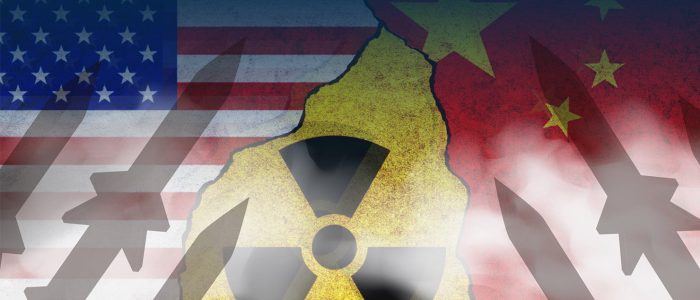Over 75 years since US nuclear weapons caused devastation in Hiroshima and Nagasaki, nuclear deterrence has held firm. Despite nuclear-armed states now understanding the wide-ranging consequences of using nuclear weapons, the threat of their use still exists today. In many ways, this threat has significantly increased in recent years, largely due to advances in Emerging and Disruptive Technologies (EDTs), the changing geopolitical landscape, and an overall deterioration of the global nuclear order. It is within this context that the US Department of Defence (DOD) released its 2023 Strategy for Countering Weapons of Mass Destruction (CWMD) on 28 September 2023.
The CWMD strategy outlines how the DOD views the pursuit, development, and use of weapons of mass destruction (WMDs). Although WMDs include chemical, biological, radiological and nuclear weapons, it is the nuclear domain which understandably holds the greatest significance, with nuclear weapons being considered as the ultimate deterrent. The strategy gives valuable insight into how the US views nuclear weapons, its global competition with China, and the future of the global nuclear order.
The CWMD strategy outlines how the US intends to deal with current and emerging WMD challenges, with specific mention given to the role of EDTs, such as big data, Artificial Intelligence (AI), and biotechnology, which could pose significant threats regarding WMDs. Although the strategy largely refers to the use of these technologies in the chemical and biological domain, EDTs pose significant threats in the nuclear domain as well.
The US has successfully portrayed China as its biggest threat and seems to be preparing for a future confrontation. With both states modernising their nuclear forces and investing heavily in EDTs, this confrontation could very well cross into the nuclear domain.
The strategy also states that the DOD must disrupt and degrade “a WMD-armed competitor’s efforts to grow and improve their indigenous WMD programs”, as well as a state’s WMD capability “prior to use in conflict”. Again, such statements become much more significant when focusing solely on the nuclear domain. The disruption of another state’s nuclear program can be done in multiple ways, such as through sanctions or trade restrictions, but also through the strategic use of EDTs. The strategy goes on to mention that “improved kinetic and non-kinetic options provide additional tools to disrupt WMD capabilities”.
Cyberspace technologies are an example of a non-kinetic option that the US could use to disrupt another state’s nuclear program. The US has already demonstrated this capability through the strategic use of the Stuxnet worm in 2010, which wreaked havoc on Iran’s nuclear program and damaged around 1,000 centrifuges in their Natanz facility. The Stuxnet worm was reportedly created by the US and Israel with the sole purpose of disrupting Iran’s nuclear program.
These days, nuclear weapons and facilities rely heavily on cyberspace to function. However, how the US would react if its nuclear facilities faced a cyber-attack is an interesting question. In their 2018 Nuclear Posture Review, the US expanded the role of nuclear weapons to be used against “significant non-nuclear strategic weapons” and “attacks on the US, allied, or partner civilian population or infrastructure”.
Likewise, AI could pose new challenges for the nuclear domain. Although no state has indicated its desire to incorporate AI into nuclear weapon systems so far, the possibility certainly exists. As the use of AI systems in the military grows and states gain confidence in their efficiency and accuracy, it is only a matter of time before AI gradually becomes integrated into nuclear weapons, particularly for command and control. Although this might prove useful in the short term, giving control of nuclear weapons over to machines would only increase the risk of nuclear escalation in the long term.
Additionally, the strategy refers to China as being the “most comprehensive and urgent” challenge for the US. The DOD lists the modernisation of “nearly every aspect” of China’s People’s Liberation Army (PLA), its pursuit of a nuclear force expansion and modernisation program, and the ambiguity surrounding its no-first-use (NFU) policy as the greatest cause for concern.
It further states that China will likely “deploy at least 1,000 nuclear warheads by 2030 and 1,500 nuclear warheads by 2035”. This is not the first time the US has accused China of this. This claim, however, is difficult to believe. According to SIPRI, China currently possesses 410 nuclear warheads. For China to more than double its current stockpile to 1,000 by 2030 seems quite far-fetched.
It is also important to note that China’s estimated nuclear weapons spending in 2022 was $11.7 billion, around a quarter of US spending at $43.7 billion. The US and Russia also still possess a much greater nuclear weapons stockpile than China, with both states having over 5,000. Ultimately, though, it does not matter whether the US estimates about China’s nuclear ambitions are correct or not. The US has successfully portrayed China as its biggest threat and seems to be preparing for a future confrontation. With both states modernising their nuclear forces and investing heavily in EDTs, this confrontation could very well cross into the nuclear domain.
Also of interest was what the strategy had to say about US allies and partners. The strategy mentioned that the DOD aimed to both protect its allies and partners from WMD use and to enable them to counter WMD use. Clearly, the US understands that the use of WMDs, particularly nuclear weapons, in a potential future conflict with China is not entirely out of the question. Its extension of support for its allies and partners, however, could prove to be problematic if applied in the nuclear domain.
With US-China tensions rising over the Taiwan issue, the rapid pace of advancements being made in military EDTs, and the Russia-Ukraine conflict showing states that they cannot rely on external powers for their security, the likelihood of nuclear escalation seems alarmingly possible.
